How to Make a Basic Lotion / Cream
In this post, I want to give you the basic information you need to make your lotions and creams. If you have never made a lotion or a cream before, this post will guide you and help you understand the basics of cosmetics lotions and creams making.
In the lotions/creams basic formula, we have 3 phases: water, oil, and cool down. Usually, we place the water and oil phases into a double boiler to heat them and melt the oil phase ingredients.
However, in some formulas, we can use ingredients that do not require heating or melting, therefore, we can make a cold emulsion without heating.
We usually heat to melt our emulsifying wax and butters, but if we choose an emulsifying wax that does not require melting, we can make a cold process emulsion.
In this post, I'm using four different emulsifying waxes to demonstrate how each will give our product different viscosity and texture.
You can help support my website and channel through the “buy me a coffee” page.
Here is the link: https://www.buymeacoffee.com/diycosmetica
Your support helps me keep sharing here more information and more formulas.

In general, lotions/creams (=emulsions) are made of a combination of water and oil. To combine water and oil, making sure they will not separate, we use a combining agent - emulsifying wax.
emulsifying wax is essential in emulsions making. We can not change the emulsifying wax with other kinds of waxes (such as beeswax, sunflower wax, berry wax, soy wax, rice bran wax etc.).
There are many options for emulsifying wax. Each supplier will have several options. When you buy an emulsifying wax, think about what your final product will be like.
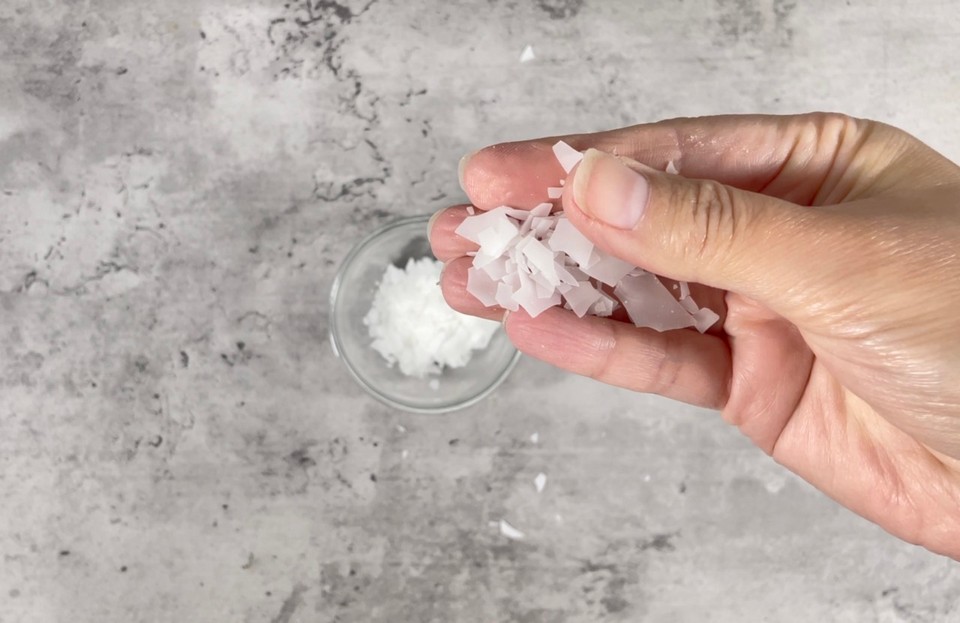
If you wish to create a thick cream or a very light lotion, then your choice for emulsifying wax will be different. If you want to buy only one emulsifying wax for different products, find one that can be more versatile and allow you to create different textures and viscosity by changing other ingredients in the formula.
So the first ingredient we will choose for our lotion/cream will be the emulsifying wax.
The emulsifying wax is usually part of the oil phase. The oil phase contains a carrier oil and the emulsifying wax.

In the oil phase, we can add butters, other waxes to thicken the product (that are not emulsifying waxes), emollients (such as lanolin, esters, fatty alcohols, fatty acids, silicones etc.) To read more about waxes in cosmetics, please check this post here.
Two of the most common ingredients to add to your oil phase are cetyl alcohol (or cetearyl alcohol) and stearic acid (emollients and thickeners). Both are excellent thickeners in lotions and creams that help to obtain a smooth and satiny feel to the final product.
I didn't add waxes or emollients other than a carrier oil and a butter in my basic formula. There are example recipes that include more emollients in the oil phase. You will find them at the end of this post.
The more emollients and thickeners you add to a formula, your product will be thicker. An example of a very dense and thick product is the emulsified body butter.
The water phase will have water-based ingredients. In the water phase, you will add the distilled water or a hydrosol, the glycerin and a gum if you choose to add a gum to your formula.

Glycerin is a humectant.
Humectants are moisturizing ingredients that work by drawing water from the atmosphere to hydrate and soften the skin (hyaluronic acid and DL-panthenol are also very commonly used humectants in skin care).
You can use distilled water or an infusion to replace the water. For example, in the Body Wash and Shampoo for Kids, I have used a calendula infusion instead of water.
You can use hydrosol or aloe vera juice to replace the water in a recipe.
We add a gum to the glycerin because it is the easiest way to incorporate a gum into our emulsion.
By mixing the gum with the glycerin, we avoid clumps and making sure the gum is evenly dispersed in the product.
The most common gum in cosmetics is xanthan gum.
Xanthan gum is a natural product which is non-toxic and non-irritating to the skin. It is very available and easy to work with.
Xanthan gum is a very effective thickening and stabilizing agent for cosmetics products.
The mixture of gum and glycerin is called a slurry. We combine the slurry into the water phase.
The third phase is the cool-down phase. We usually add the preservative and the fragrance oil (or essential oil) in the cool-down phase.
We call this the cool-down phase because we only add the ingredients in this phase once the emulsion has cooled down to 40 degrees Celsius or less. Many preservatives are heat sensitive, so we add them after the temperature has cooled down, this way they will stay effective and not lose their preservation ability.
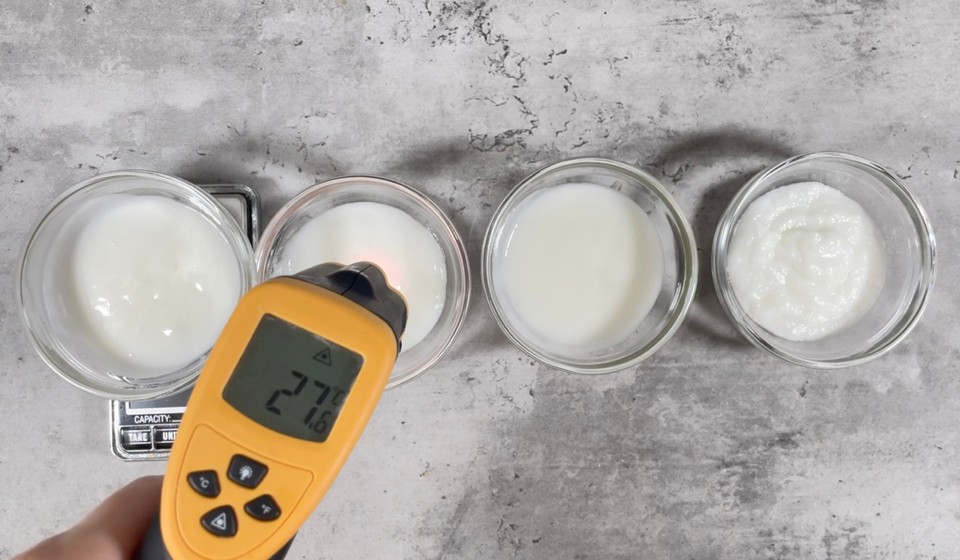
In the cool-down phase, we usually add heat-sensitive additives such as extracts.
It is essential to check the ph level of the product.
In many cases, the preservative will be effective only in a certain ph range, so we will check the ph before adding the preservative.
If we need to adjust the product ph, we will do so before adding the preservative.
We will also check the ph after adding the cool-down phase to make sure the ingredients in the cool-down phase did not change the ph of the product.
I have explained how to adjust the ph in cosmetics products in this post.
When you test the ph level of your product, you can use 1g of product with 9gof distilled water, mix them and check the ph.
I find that dipping the ph strip inside the product gives me accurate results in creams, lotions, and other products that are not used together with water.
Although some formulators insist you must dilute your product to test the ph, from my experience, this is not a must.
I have checked many products with a ph meter and with ph stripes using both methods and decided for my personal use that it is fine to dip the strip inside the product when it's a lotion or a cream.
So now we know we need an oil phase, a water phase and a cool-down phase.
Once we prepare the oil phase and the water phase, we will place them into a double boiler for the oil phase to melt.
We are putting both phases into a double boiler to ensure they will have a similar temperature when we combine them.
Some formulators will say you need to ‘heat and hold’ both phases for 20 minutes at 70 degrees Celsius.
From my experience, there is no need to hold the phases for 20 minutes. When my oil phase is completely melted, I wait another 2 minutes and take both phases out of the heat to combine them.
The heating temperature depends on the melting point of the ingredients you use. Some ingredients will melt at less than 70 degrees Celsius, and some will need a higher temperature to melt.
Once melted, you can remove the phases from the heating and combine them.
You can mix with a whisk for small batches or even stir the emulsion with a glass rod. If you make a large batch, you will need an immersion blender to ensure everything is well combined and fully emulsified.
Once we add the cool-down phase, we mix to combine it, and our product is ready.
Please check this post to read about basic ingredients and tools to use in cosmetics.
Formula for a basic lotion:
Oil phase
- Carrier oil 8% (I’m using sweet almond oil)
- Butter 3% (I’m using shea butter)
- Emulsifying wax 4% (I made 4 different batches with different emulsifying waxes)
Water phase
- Distilled water 77.5%
- Glycerin 5%
- Xanthan gum 0.5%
Cool down phase
- Preservative 1%
- Fragrance oil 1%
I made 50g for each batch of lotion.
Method:
- Start by sanitizing your tools and containers. After washing everything with soap and water, spray your tools and containers with rubbing alcohol (isopropyl alcohol). I am using 70% isopropyl alcohol.

- In a heat resistant beaker, add the water phase ingredients. Start with glycerin.

- Add the xanthan gum to the glycerin and mix to make a slurry.


- Add the distilled water to the slurry and mix to combine.

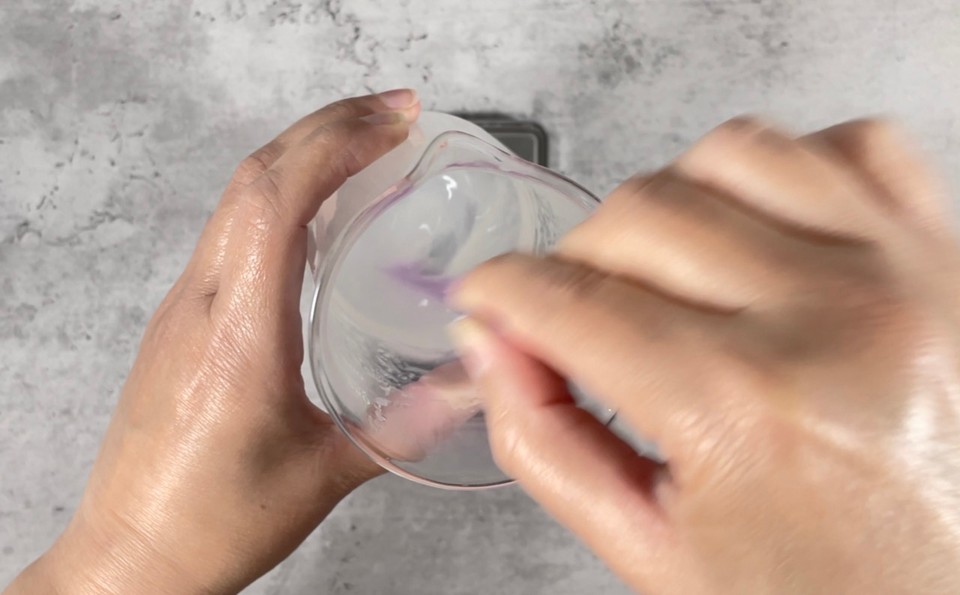
- Cover the water phase beaker to minimize water evaporation (when working with bigger batches, you should scale your water phase before heating and after removing it from the heat. Calculate the water evaporated during the heating and add the missing amount to the water phase beaker).

- In another heat resistant beaker, add the oil phase ingredients. Start with the emulsifying wax.

- Add the oil and the butter.


- Place the oil and water phases into a double boiler on medium heat.

- After the oil phase has completely melted, remove both phases from the heat.

- Pour the water phase into the oil phase and start mixing to combine.

- Mix until the emulsion is stable. It can take a few minutes to mix if you are not using an immersion blender.
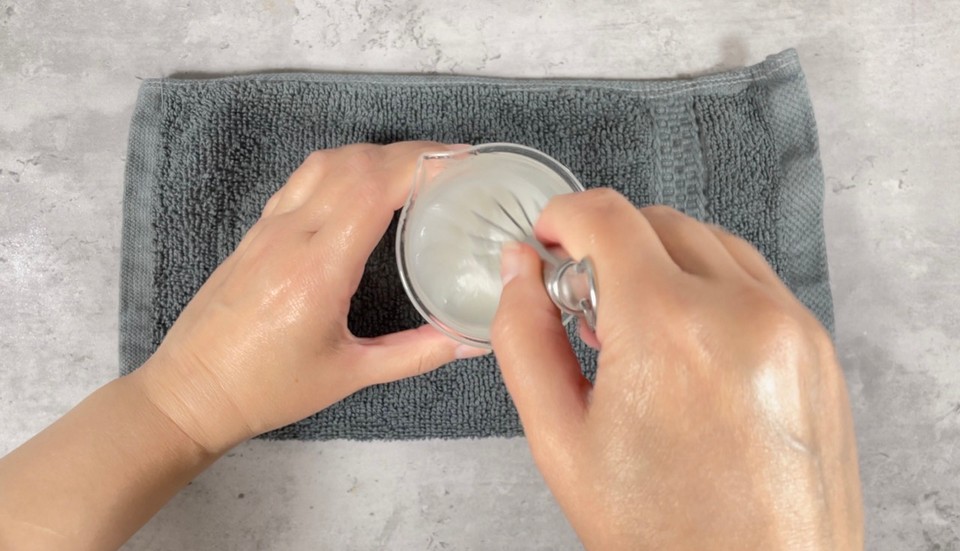
- Check the ph and adjust if necessary once your emulsion has cooled down to less than 40 degrees Celsius. To learn about ph adjustment, please check this post. Ph between 5 to 6.5 will be fine for a body lotion.

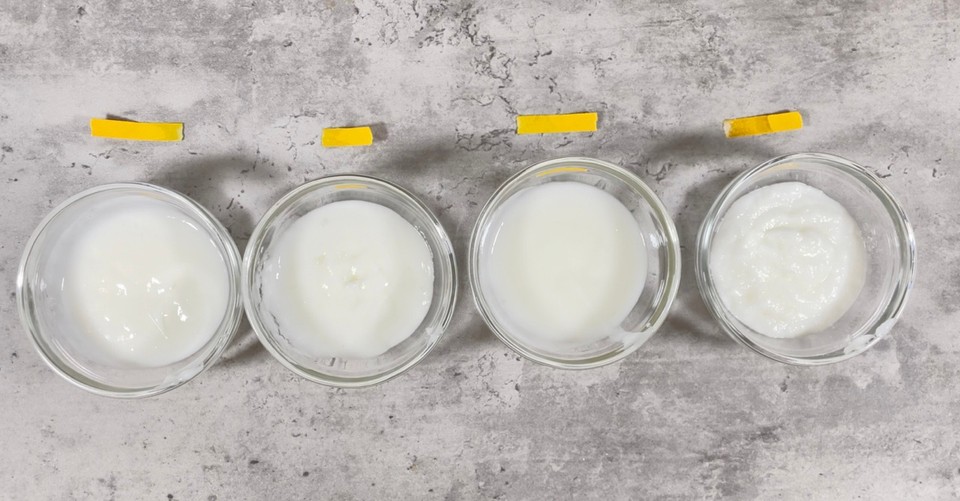
- After the ph checking and adjusting, add the cool-down phase. Add the preservative and the fragrance oil (or essential oil). Mix to combine. Your lotion is ready.
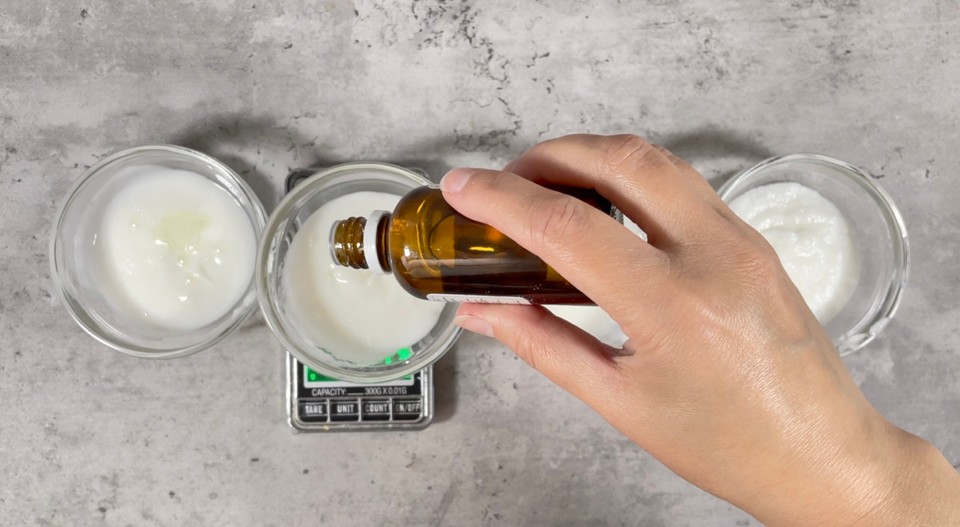
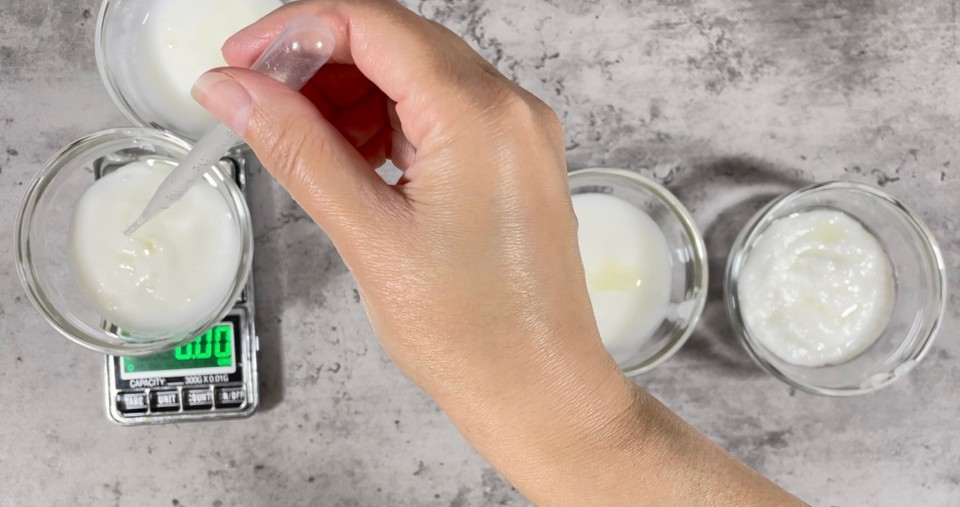

As I have mentioned at the beginning of this post, I have used four different emulsifying waxes to show you the different results you can get with each.
In the first batch, I used methyl glucose sesquistearate (it's a non-ionic carbohydrate-based surfactant and emulsifier). It's a mixture of the di-esters of simple sugar methyl glucoside and the fatty acid stearic acid.

Methyl glucose sesquistearate is vegetable-derived.
This E-wax gives a light-medium viscosity and smooth, silky texture.

In the second batch, I used olivem1000 (INCI: Cetearyl olivate, Sorbitan olivate). It's a non-ionic emulsifier obtained by combining sorbitol, Cetearyl alcohol and certain essential fatty acids extracted from olive oil.

It's a Plant-Derived emulsifier.
The olivem1000 gives a medium viscosity, smooth and creamy emulsion. It is a very easy emulsifier to work with. Olivem1000 has conditioning properties, making it perfect for all lotion and cream making.
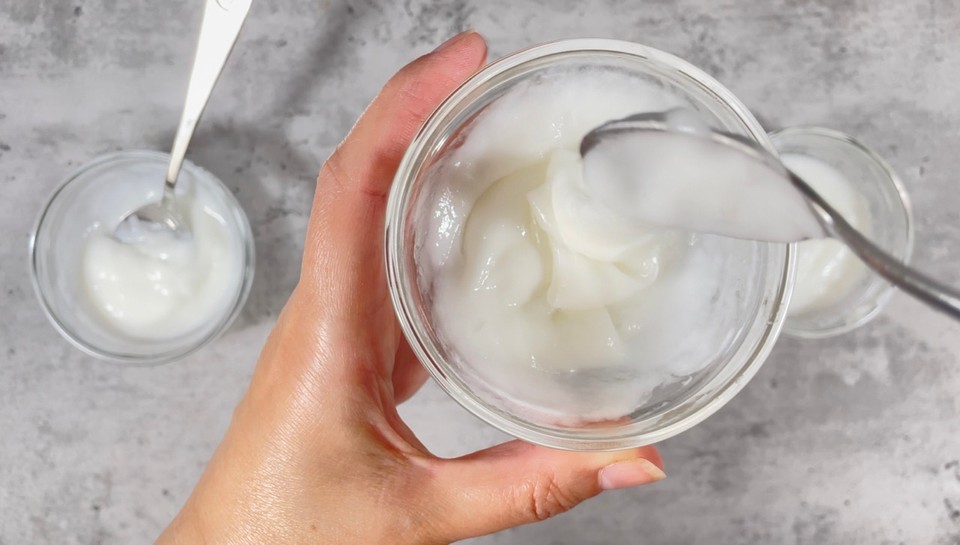
Recipes using the olivem1000 emulsifying wax: Light Body Lotion, Emulsified Body Butter, Moisturizing Body Lotion and Summer Breeze Body Lotion.
In the third batch, I used glyceryl stearate + peg 100 stearate.
It's a non-ionic emulsifier driven from Palm Oil.

It gives super light emulsions, so often used with a thickener in formulations such as cetyl alcohol or stearic acid.

It is an excellent emulsifying wax for sprayable lotions or light viscosity lotion/cream. It is a synthetic emulsifier.
In the fourth batch, I used BTMS 50 (INCI: Behentrimonium Methosulfate (and) Cetyl Alcohol (and) Butylene Glycol).
This is a cationic emulsifier (positively charged) and a conditioning agent. BTMS 50 or BTMS 25 are very common in hair care products. BTMS 50 is a quaternary ammonium salt derived from the natural plant oil Colza.
BTMS is cationic so when adding a gum to help with stability chose Guar Gum (Non-ionic charge) instead of xanthan gum (anionic charge), although some suppliers sell xanthan gum that can be compatible with cationic ingredients (you can find this information in the data sheets of the ingredients on the supplier’s website).
So if you use BTMS change the xanthan gum with Guar gum in the recipe.

BTMS 50 gives a more dense and creamy texture to the finished product. It adds conditioning properties to the product.

I usually use BTMS 50 or 25 in my hair products, such as : Marble Shikakai Shampoo Bar, Solid Shampoo Bar for Dry Hair, Mango Butter Solid Conditioner Bar, Amla Hair Mask and Avocado Hair Mask.
BTMS 50 or BTMS 25 sometimes takes forever to melt. If you have a coffee grinder, you can grind the BTMS into a powder before adding it to the oil phase. This way, it will melt faster and will be easier to work with.
As you can gather, the different emulsifying waxes give different results. So depending on the final viscosity and feel you want to obtain in your lotion/cream, you will use different ingredients.
Something to take into consideration when swapping emulsifying wax in a recipe - each type of emulsifying wax has a different stability properties, that means that some will work well with a gum added to the formula and some will need other ingredients to create a stable emulsion. Some emulsifying waxes will need a co-emulsifier ingredient. The best way to insure your products are stable, and will not separate in time, is to check the data sheet provided by the supplier, you can get the information regarding the specific emulsifying wax and the best way to incorporate it to the emulsion (some will require high speed mixing while others can be mix with low speed). This is something to keep in mind when you swap a specific emulsifying wax with another.


Here are more recipe examples you can use and change after experimenting with making lotions/creams:
Recipe for a light body lotion:
Oil phase
- Carrier oil 12g
- Emulsifying wax 4g
- Cetyl alcohol 1g
Water phase
- Distilled water 77.8g
- Glycerin 3g
- Xanthan gum 0.2g
Cool down phase
- Preservative 1g
- Essential oil (lavender) 0.5g
- Essential oil (Patchouli) 0.5g
You can use sweet almond oil, macadamia oil, hazelnut oil, safflower oil, rice bran oil, fractionated coconut oil, argan oil, grapeseed oil or apricot kernel oil.
You can use fragrance oil or a different blend of essential oils. Use safe essential oils (some essential oils are irritating or cannot be used while pregnant or breastfeeding).
When choosing a preservative, check the supplier instructions regarding usage rate and ph range for the specific preservative. If you need to use 2% preservative, you can subtract 1% of the water phase (76.8g water and 2g preservative in a 100g batch).
Recipe for rich body lotion:
Oil phase
- Carrier oil 10g
- Shea butter 6g
- Emulsifying wax 4g
- Cetyl alcohol 2g
- Stearic acid 1g
Water phase
- Distilled water 68.6g
- Glycerin 6g
- Xanthan gum 0.4g
Cool down phase
- Preservative 1g
- Fragrance oil 1g (for example: melon, pineapple, apple or coconut fragrance oil)
You can use avocado oil, olive oil, jojoba oil, macadamia oil, hazelnut oil, argan oil, grapeseed oil or sunflower oil.
You can use fragrance oil or a blend of essential oils. Use safe essential oils (some essential oils are irritating or cannot be used while pregnant or breastfeeding).
When choosing a preservative, check the supplier instructions regarding usage rate and ph range for the specific preservative. If you need to use 2% preservative, you can subtract 1% of the water phase (67.6g water and 2g preservative in a 100g batch).
Recipe for a Calendula cream:
Oil phase
- Calendula oil 16g (to learn how to infused oils please check this post)
- Cocoa butter 4g
- Emulsifying wax 5g
- Beeswax 2g
Water phase
- Distilled water 64g
- Glycerin 4g
- Xanthan gum 0.5g
Cool down phase
- Preservative 1g
- Calendula extract 2g
- Vitamin E 0.5g
- Essential oil (vanilla) 1g
You can infuse calendula dried petals with: sweet almond oil, macadamia oil, hazelnut oil, safflower oil, rice bran oil, fractionated coconut oil, argan oil, grapeseed oil or apricot kernel oil. To learn about infusing oils, please read this post.
You can use different essential oils. Use safe essential oils (some essential oils are irritating or cannot be used while pregnant or breastfeeding).
When choosing a preservative, check the supplier instructions regarding usage rate and ph range for the specific preservative. If you need to use 2% preservative, you can subtract 1% of the water phase (63g water and 2g preservative in a 100g batch).
You can use oats extracts, aloe vera extract or any other extract with calming properties instead of the calendula extract.
Related articles:
- Light Body Lotion
- Emulsified Body Butter
- Waxes in Cosmetics
- Ingredients and Tools to Start Making Your Cosmetics
- Infusing Oils (no heating)
- Moisturizing Body Lotion
- Summer Breeze Body Lotion
- How to Adjust the PH Level in Cosmetics
- Jasmine Hand Cream
- Camomile Face Cream

